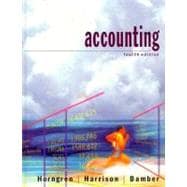
Note: Supplemental materials are not guaranteed with Rental or Used book purchases.
Purchase Benefits
What is included with this book?
1. ACCOUNTING AND THE BUSINESS ENVIRONMENT.
2. RECORDING BUSINESS TRANSACTIONS.
3. MEASURING BUSINESS INCOME: THE ADJUSTING PROCESS.
4. COMPLETING THE ACCOUNTING CYCLE.
5. MERCHANDISING OPERATIONS AND THE ACCOUNTING CYCLE.
6. ACCOUNTING INFORMATION SYSTEMS: SPECIAL JOURNALS, CONTROL ACCOUNTS, AND SUBSIDIARY LEDGERS.
7. INTERNAL CONTROL, MANAGING CASH, AND MAKING ETHICAL JUDGMENTS.
8. ACCOUNTS AND NOTES RECEIVABLE.
9. ACCOUNTING FOR MERCHANDISE INVENTORY.
10. ACCOUNTING FOR PLANT ASSETS, INTANGIBLE ASSETS, AND RELATED EXPENSES.
11. CURRENT LIABILITIES AND PAYROLL ACCOUNTING.
12. ACCOUNTING FOR PARTNERSHIPS.
13. CORPORATE ORGANIZATION, PAID-IN CAPITAL, AND THE BALANCE SHEET.
14. RETAINED EARNINGS, TREASURY STOCK, AND THE INCOME STATEMENT.
15. LONG-TERM LIABILITIES.
16. ACCOUNTING FOR INVESTMENTS AND INTERNATIONAL OPERATIONS.
17. PREPARING AND USING THE STATEMENT OF CASH FLOWS.
18. FINANCIAL STATEMENT ANALYSIS.
19. INTRODUCTION TO MANAGEMENT ACCOUNTING.
20. JOB COSTING.
21. PROCESS COSTING.
22. COST-VOLUME-PROFIT ANALYSIS AND THE CONTRIBUTION MARGIN APPROACH TO DECISION MAKING.
23. THE MASTER BUDGET AND RESPONSIBILITY ACCOUNTING.
24. FLEXIBLE BUDGETS AND STANDARD COSTS.
25. ACTIVITY-BASED COSTING AND OTHER TOOLS FOR COST MANAGEMENT.
26. SPECIAL BUSINESS DECISIONS AND CAPITAL BUDGETING.
The New copy of this book will include any supplemental materials advertised. Please check the title of the book to determine if it should include any access cards, study guides, lab manuals, CDs, etc.
The Used, Rental and eBook copies of this book are not guaranteed to include any supplemental materials. Typically, only the book itself is included. This is true even if the title states it includes any access cards, study guides, lab manuals, CDs, etc.